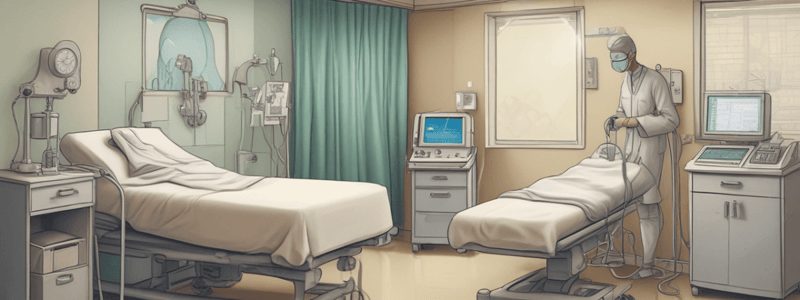Podcast
Questions and Answers
What is the primary goal of airway clearance techniques?
What is the primary goal of airway clearance techniques?
- To increase airflow resistance
- To promote coughing in patients
- To induce gagging in patients
- To improve secretions clearance (correct)
What is the purpose of suctioning in patients with artificial airways?
What is the purpose of suctioning in patients with artificial airways?
- To aspirate secretions when patients have difficulty handling them (correct)
- To remove tracheal tubes from patients
- To facilitate coughing in patients
- To improve oxygenation in patients without airways
What is the recommended method for accessing the lower airway?
What is the recommended method for accessing the lower airway?
- Through the esophagus
- Through an artificial airway (endotracheal suctioning)
- Through the nose (Nasotracheal suctioning) (correct)
- Through the mouth
What should be removed from the oropharynx using a rigid tonsillar or Yankauer suction tip?
What should be removed from the oropharynx using a rigid tonsillar or Yankauer suction tip?
Why is tracheal suctioning through the mouth not recommended?
Why is tracheal suctioning through the mouth not recommended?
What is required for removing foreign bodies, secretions, or tissue masses beyond the main stem bronchi?
What is required for removing foreign bodies, secretions, or tissue masses beyond the main stem bronchi?
What is the application of negative pressure to the airways through a collecting tube connected to a suction machine or wall suction outlet?
What is the application of negative pressure to the airways through a collecting tube connected to a suction machine or wall suction outlet?
What is the role of respiratory therapists in performing bronchoscopy?
What is the role of respiratory therapists in performing bronchoscopy?
What is the main reason for suctioning in upper airways?
What is the main reason for suctioning in upper airways?
What is the benefit of using a whistle-tipped suction catheter?
What is the benefit of using a whistle-tipped suction catheter?
What is the unit of measurement for suction catheter sizes?
What is the unit of measurement for suction catheter sizes?
What is the recommended size of suction catheter for adults?
What is the recommended size of suction catheter for adults?
What is the purpose of the thumb port on a suction catheter?
What is the purpose of the thumb port on a suction catheter?
What is the rule of thumb for estimating the proper size of suction catheter to use with a given endotracheal tube?
What is the rule of thumb for estimating the proper size of suction catheter to use with a given endotracheal tube?
Why is it important to avoid using a suction catheter with a diameter larger than 50% of the internal diameter of the artificial airway?
Why is it important to avoid using a suction catheter with a diameter larger than 50% of the internal diameter of the artificial airway?
What is the typical length of most suction catheters for adult general purposes?
What is the typical length of most suction catheters for adult general purposes?
What is the recommended duration of delivering 100% oxygen to patients before suctioning?
What is the recommended duration of delivering 100% oxygen to patients before suctioning?
What is the purpose of hyperinflating the patient before suctioning?
What is the purpose of hyperinflating the patient before suctioning?
What is the advantage of using the closed suction technique?
What is the advantage of using the closed suction technique?
How should the suction catheter be inserted into the artificial airway?
How should the suction catheter be inserted into the artificial airway?
What should be done when resistance is met or the patient coughs during suctioning?
What should be done when resistance is met or the patient coughs during suctioning?
What is the recommended time for the catheter to remain in the airway during suctioning?
What is the recommended time for the catheter to remain in the airway during suctioning?
What should be done to the catheter and connecting tube after suctioning?
What should be done to the catheter and connecting tube after suctioning?
Why is it recommended to encourage the patient to deep breathe after suctioning?
Why is it recommended to encourage the patient to deep breathe after suctioning?
What position should the patient assume to facilitate catheter passage through the larynx?
What position should the patient assume to facilitate catheter passage through the larynx?
What is the purpose of twisting the catheter if resistance is felt in the nose?
What is the purpose of twisting the catheter if resistance is felt in the nose?
What is the indication for sputum induction?
What is the indication for sputum induction?
What is the technique used in sputum induction?
What is the technique used in sputum induction?
What percentage of patients obtain an adequate specimen through sputum induction?
What percentage of patients obtain an adequate specimen through sputum induction?
What type of PPE is recommended for suctioning oral secretions and open suctioning of airways?
What type of PPE is recommended for suctioning oral secretions and open suctioning of airways?
What is a technique to minimize or decrease complications of suctioning?
What is a technique to minimize or decrease complications of suctioning?
What type of PPE is recommended for sputum induction in a patient with suspected TB?
What type of PPE is recommended for sputum induction in a patient with suspected TB?
What is the result of vagal nerve stimulation due to irritation of the larynx or trachea?
What is the result of vagal nerve stimulation due to irritation of the larynx or trachea?
What should be done if hypotension or hypertension occurs during suctioning?
What should be done if hypotension or hypertension occurs during suctioning?
What is the recommended technique to prevent mucosal damage during suctioning?
What is the recommended technique to prevent mucosal damage during suctioning?
What is the recommended duration of suctioning to prevent micro-atelectasis?
What is the recommended duration of suctioning to prevent micro-atelectasis?
What is the recommended position for semi-conscious patients during suctioning?
What is the recommended position for semi-conscious patients during suctioning?
What is the purpose of using sterile water-soluble lubricating jelly in nasotracheal suctioning?
What is the purpose of using sterile water-soluble lubricating jelly in nasotracheal suctioning?
What is the key difference between nasotracheal and endotracheal suctioning?
What is the key difference between nasotracheal and endotracheal suctioning?
What should be considered for patients who require repeated, long-term nasotracheal suctioning?
What should be considered for patients who require repeated, long-term nasotracheal suctioning?
Study Notes
Suctioning
- Suctioning is the application of negative pressure (vacuum) to the airways through a collecting tube (flexible catheter or suction tip) connected to a suction machine or wall suction outlet for aspirating secretions from the airways.
- The goal of airway clearance techniques is to improve secretions clearance, prevent secretion retention, decrease obstruction of airways, and improve gas exchange.
Sites for Suctioning
- Upper airways:
- Nasopharyngeal suctioning
- Oropharyngeal suctioning
- Lower airways:
- Endotracheal suctioning
- Tracheostomy suctioning
Indications for Suctioning
- Need to maintain patency and integrity of the artificial airway
- Need to remove accumulated pulmonary secretions
- Need to obtain a sputum specimen to rule out or identify pneumonia or other pulmonary infections
- Need to obtain a sputum specimen for sputum cytology
Contraindications for Suctioning
- No absolute contraindications to endotracheal suctioning, but there are hazards and complications to be aware of
Equipment: Suction Catheters
- Suction catheters are either open-tipped or whistle-tipped
- Catheter sizes are measured in French units (external circumference)
- Sizes: #12 to #18 Fr for adults, #8 to #10 Fr for children, #5 to #8 Fr for infants
- Rule of thumb: to estimate the proper size of suction catheter, multiply the inner diameter of the endotracheal tube by 2, then use the next smallest size catheter
Endotracheal or Tracheostomy Tube Suctioning
- Hyperinflate and/or hyperoxygenate the patient before suctioning
- Use 100% oxygen for 30 to 60 seconds, especially for patients at risk for hypoxemia
- Use either open or closed suction technique
- Insert the catheter into the artificial airway without applying suction, then pull back 1 cm
- Apply intermittent suction by placing and releasing the non-dominant thumb over the vent of the catheter
- Withdraw the catheter while rotating it back and forth between the dominant thumb and forefinger
Hazards and Complications of Suctioning
- Vagal nerve stimulation: bradycardia, tachycardia, or hypotension
- Mucosal damage: trauma to the mucosa due to using suction while inserting a catheter
- Micro-atelectasis: using too large a suction catheter or applying too much negative suction pressure
- Aspiration: risk of aspiration in semi-conscious patients
- Infection: follow protocol for sterile procedure and use closed suction technique
Nasotracheal Suctioning
- Indicated for patients who have retained secretions but do not have an artificial airway
- Similar to endotracheal suctioning, but with additional equipment and supplies
- Use sterile water-soluble lubricating jelly to aid catheter passage through the nose
- Insert the catheter gently through the nostril, directing it toward the septum and floor of the nasal cavity
Techniques to Minimize Complications of Suctioning
- Suction only as needed
- Use sterile technique
- Hyperinflate
- Hyperoxygenate
- Use safe catheter size
- No saline instillation
- Use closed suction technique
- Never suction while inserting a catheter
Sputum Induction
- Indications: cough without sputum, negative sputum smear with high clinical suspicion of tuberculosis
- Technique: inhalation of hypertonic saline (3%) with ultrasonic or air compressor nebulizer, possible addition of B2 agonist
- Yield: adequate specimen obtained in 85 to 99% of cases
PPE for Suctioning
- Suctioning oral secretions and open suctioning of airways: gloves and mask/goggles or a face shield, sometimes gown
- Sputum induction in a patient with suspect TB: masks and gowns
Studying That Suits You
Use AI to generate personalized quizzes and flashcards to suit your learning preferences.
Related Documents
Description
Learn about the objectives of suctioning, including identification, sites, indications, and contraindications. Explore the differences between oropharyngeal, nasopharyngeal, endotracheal, and tracheostomy suctioning, as well as hazards and complications.




